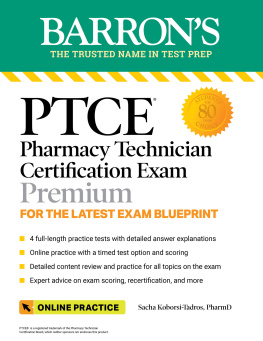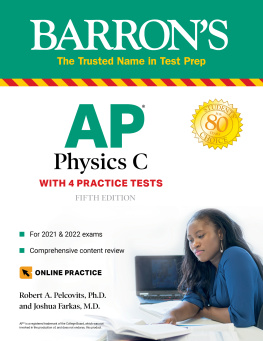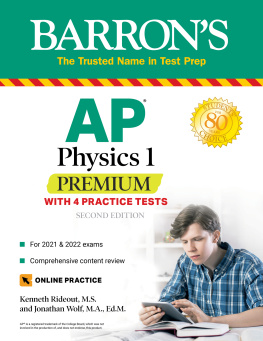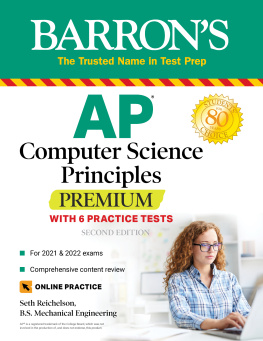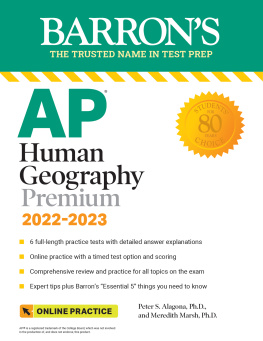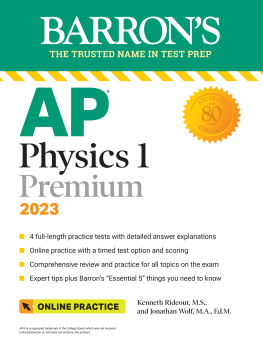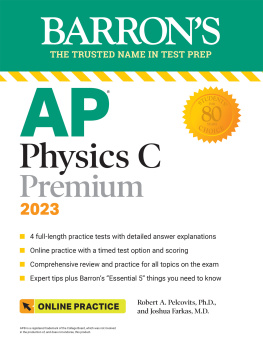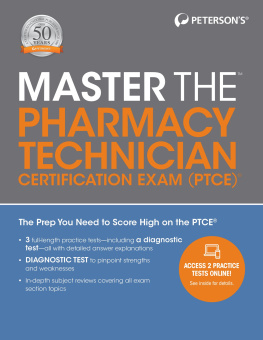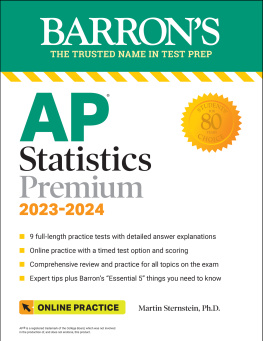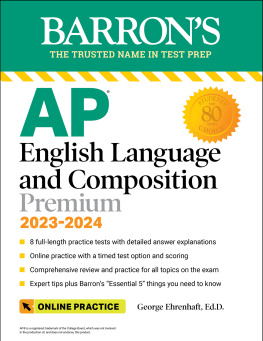Table of Contents
Guide
Page List

Acknowledgments
For Nelson, Philip, Michael, Ava, and Matthew.
Note
While the content of this text was written based on all of the most current information available regarding the pharmacy technician profession and the PTCE, readers are still advised to consult with their employers and the Pharmacy Technician Certification Board website (http://ptcb.org/) for the latest pharmacy technician standards and guidelines that are applicable to their state.
The presence of knowledge domains in this publication has been determined subjectively by the author. While the author has made every attempt to categorize information by a singular knowledge domain, there may be times when the concepts relate to multiple domains.
This publication is designed to provide accurate information in regard to the subject matter covered as of its publication date, with the understanding that knowledge and best practice constantly evolve. The publisher is not engaged in rendering medical, legal, accounting, or other professional service. If medical or legal advice or other expert assistance is required, the services of a competent professional should be sought. This publication is not intended for use in clinical practice or the delivery of medical care. To the fullest extent of the law, neither the Publisher nor the Editors assume any liability for any injury and/or damage to persons or property arising out of or related to any use of the material contained in this book.
For the purposes of this publication, trademark symbols have been deleted.
Copyright 2022, 2020, 2018, 2016, 2014, 2012, 2010, 2007, 2004, 2000 by Kaplan North America, LLC d/b/a Barrons Educational Series
All rights reserved under International and Pan-American Copyright Conventions. By payment of the required fees, you have been granted the non-exclusive, non-transferable right to access and read the text of this eBook on screen. No part of this text may be reproduced, transmitted, downloaded, decompiled, reverse engineered, or stored in or introduced into any information storage and retrieval system, in any form or by any means, whether electronic or mechanical, now known or hereinafter invented, without the express written permission of the publisher.
Published by Kaplan North America, LLC d/b/a Barrons Educational Series
1515 W Cypress Creek Road
Fort Lauderdale, FL 33309
www.barronseduc.com
ISBN: 978-1-5062-8043-1
10 9 8 7 6 5 4 3 2 1
About the Author
Sacha Koborsi-Tadros received her Doctor of Pharmacy degree from The Chicago College of Pharmacy at Midwestern University. She is a nationally recognized educator as well as a pharmacy consultant and professional speaker. Dr. Koborsi-Tadros is an Assistant Professor of Allied Health at Columbus State Community College in Columbus, OH, where she also serves as the Director of the Pharmacy Technician Program.
As an educator, Dr. Koborsi-Tadros engages students with a multifaceted approach to health care, with a primary focus on holistic wellness and an integrated health care model. She has a special interest in substance abuse prevention and treatment, and she has received national certifications in pain management, the treatment of opioid use disorder, and medication safety. Dr. Koborsi-Tadros has also received numerous awards for her educational work, including being named the 2019 recipient of the Health and Human Services Division Faculty Award for Excellence and the 2020 Top 10 Distinguished Teacher Award finalist at her college.
As a consultant, Dr. Koborsi-Tadros has a vital role in advancing pharmacy technician education by serving as a consultant to the Ohio Department of Higher Education. She has a passion for education and is an advocate for pharmacy technician training and advancement.
Table of Contents
This book provides comprehensive review and extensive practice for the latest Pharmacy Technician Certification Exam (PTCE) blueprint.
Exam Overview
Start with , which discusses the Pharmacy Technician Certification Board (also known as the PTCB), a nongovernmental agency that administers the PTCE, and provides a detailed overview of the PTCE, including a breakdown of the four knowledge domains that make up this test and the percentage of exam content devoted to each domain. Review the directions for scheduling your exam, and learn how the exam will be scored.
Preparing for the Exam and Steps for Recertification
Next, review , which offers advice leading up to test day, on the actual day of the exam, and following the exam. Then, review the requirements for recertification or reinstatement of certification to make sure youre up-to-date on the latest information.
Pretest
Then, take the full-length pretest in . The pretest is designed to assess your strengths and weaknesses before beginning your review. Once youve finished the pretest, read through all of the detailed answer explanations, especially for the questions that you missed, to see which topics you know well and which you may want to brush up on.
Review and Practice
Study , which are organized according to the four knowledge domains of the PTCE: Medications, Federal Requirements, Patient Safety and Quality Assurance, and Order Entry and Processing. Each chapter focuses on one domain and provides a thorough review of the most frequently tested topics. There are figures throughout that illustrate key concepts as well as detailed tables that summarize essential medication details, recall classifications, error prevention strategies, and much more. There are tips and notes with expert advice throughout these chapters, and each chapter concludes with ten practice questions and detailed answer explanations that allow you to check your progress.
Practice Tests
There are two full-length practice tests that mirror the actual PTCE in format, content, and level of difficulty. These tests assess your knowledge based on all domain areas, and the percentage of each content area is based on the actual PTCE structure. Each test is followed by detailed answers and explanations for all questions.
Appendices
This book concludes with 12 appendix sections that provide a quick reference for the latest essential information that every pharmacy technician should be familiar with. Tables include common drugs (by brand name and by classification and use), vitamins, commonly used pharmacy abbreviations, important math conversions, and much more.
Online Practice
There is also one additional full-length practice test online. Like the book tests, the online test provides an in-depth review of all knowledge domains and is structured to mimic the actual exam. You may take this test in practice (untimed) mode or in timed mode. All questions are answered and explained. Refer to the card at the beginning of this book, which provides instructions for accessing this test.
One Final Note
Use this book to supplement your current pharmacy-related knowledge as you prepare for your certification exam. Determine what you know. Make a list of topics that you need to review further as you continue to prepare for your test. Take the practice tests to simulate the conditions you will encounter on test day and to practice what youve learned. Congratulations on your journey to embark on a career in pharmacy. Best of luck on your exam!

